Fashion Business Model Innovation
VerifiedAdded on 2020/02/24
|10
|2150
|45
AI Summary
This assignment focuses on restructuring a fashion business model to be more customer-oriented. It emphasizes the importance of understanding customer needs and tailoring products and services to meet them. The business model should incorporate the use of VR and AR technologies to enhance the customer experience and differentiate the company within the competitive fashion landscape. Market segmentation is also crucial, as the model should target specific customer groups based on their preferences and behaviors.
Contribute Materials
Your contribution can guide someone’s learning journey. Share your
documents today.
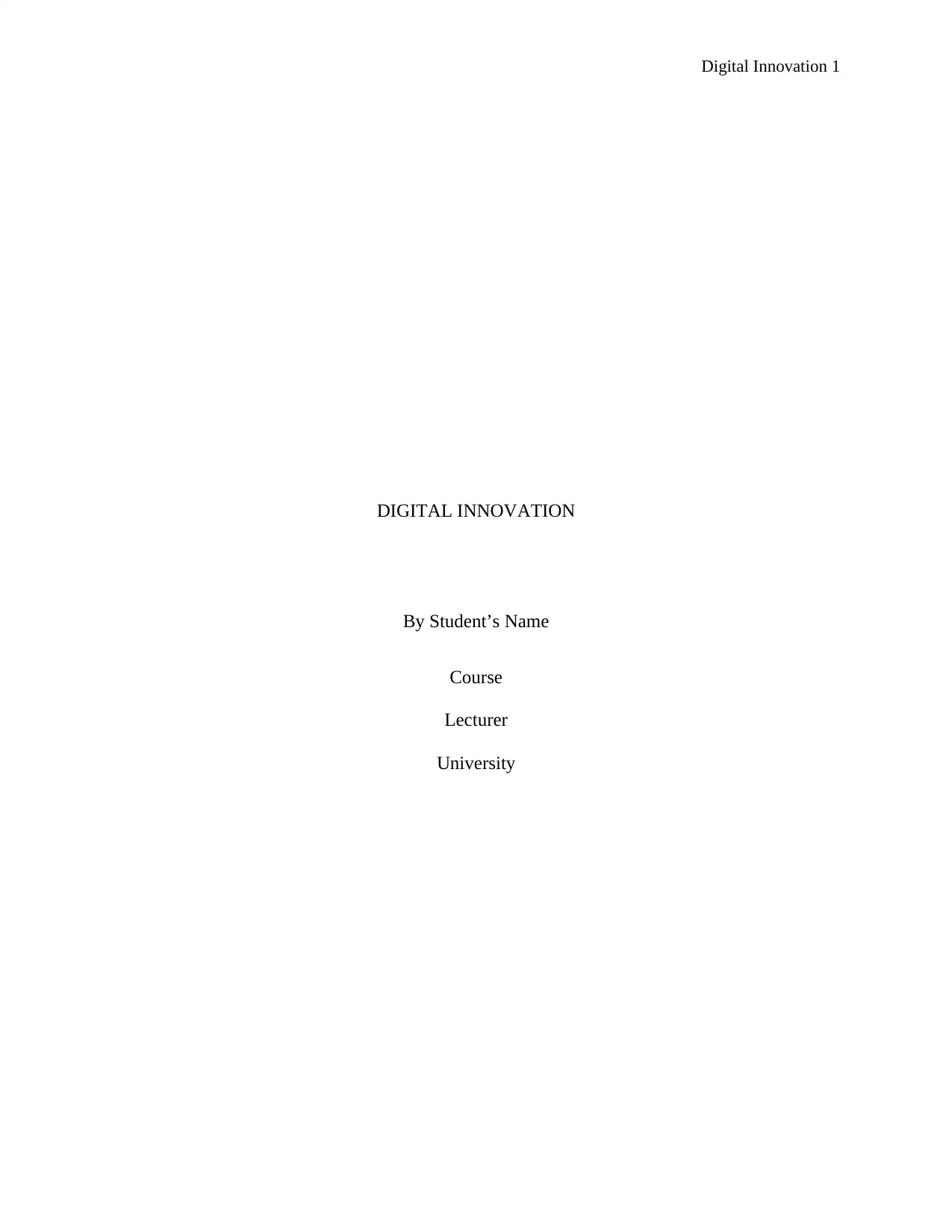
Digital Innovation 1
DIGITAL INNOVATION
By Student’s Name
Course
Lecturer
University
DIGITAL INNOVATION
By Student’s Name
Course
Lecturer
University
Secure Best Marks with AI Grader
Need help grading? Try our AI Grader for instant feedback on your assignments.
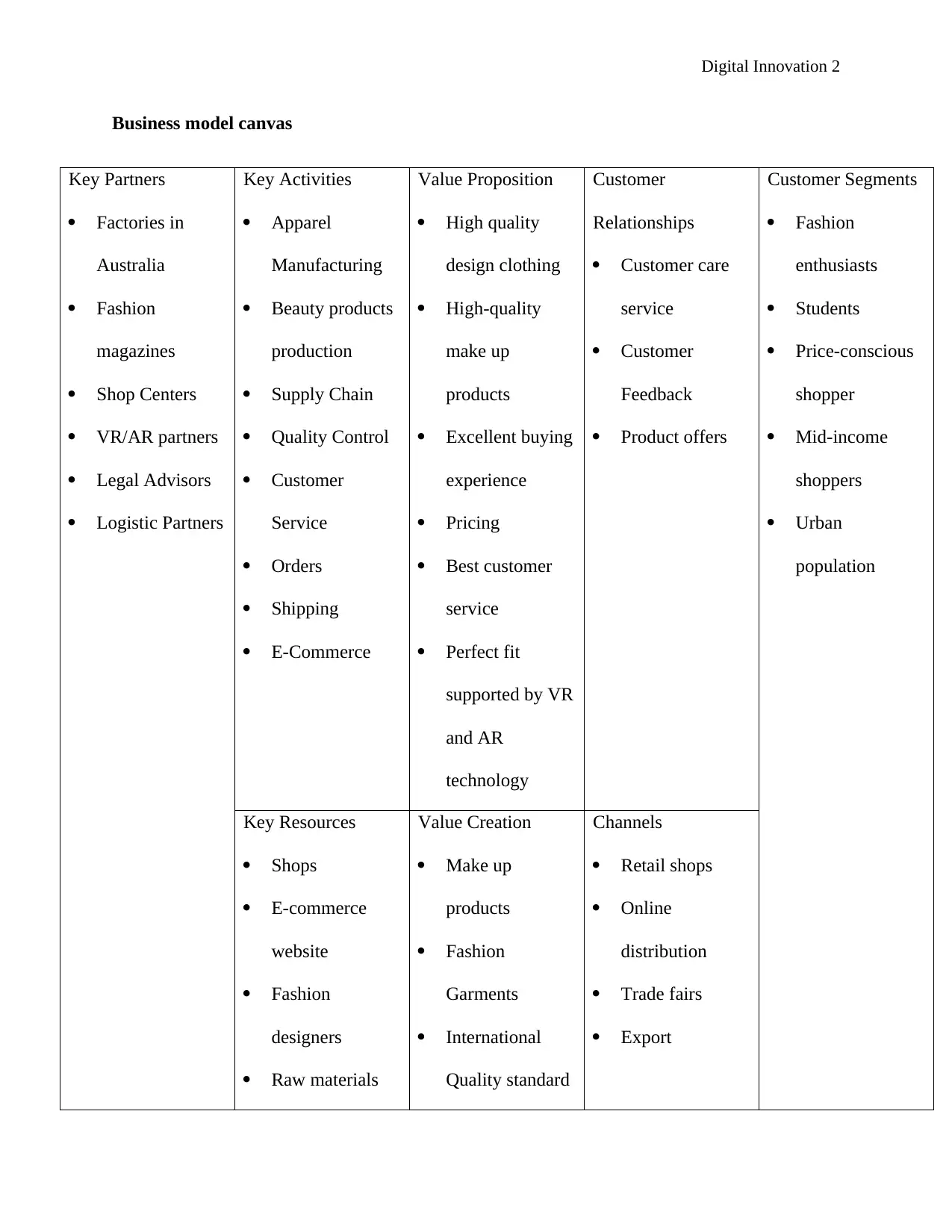
Digital Innovation 2
Business model canvas
Key Partners
Factories in
Australia
Fashion
magazines
Shop Centers
VR/AR partners
Legal Advisors
Logistic Partners
Key Activities
Apparel
Manufacturing
Beauty products
production
Supply Chain
Quality Control
Customer
Service
Orders
Shipping
E-Commerce
Value Proposition
High quality
design clothing
High-quality
make up
products
Excellent buying
experience
Pricing
Best customer
service
Perfect fit
supported by VR
and AR
technology
Customer
Relationships
Customer care
service
Customer
Feedback
Product offers
Customer Segments
Fashion
enthusiasts
Students
Price-conscious
shopper
Mid-income
shoppers
Urban
population
Key Resources
Shops
E-commerce
website
Fashion
designers
Raw materials
Value Creation
Make up
products
Fashion
Garments
International
Quality standard
Channels
Retail shops
Online
distribution
Trade fairs
Export
Business model canvas
Key Partners
Factories in
Australia
Fashion
magazines
Shop Centers
VR/AR partners
Legal Advisors
Logistic Partners
Key Activities
Apparel
Manufacturing
Beauty products
production
Supply Chain
Quality Control
Customer
Service
Orders
Shipping
E-Commerce
Value Proposition
High quality
design clothing
High-quality
make up
products
Excellent buying
experience
Pricing
Best customer
service
Perfect fit
supported by VR
and AR
technology
Customer
Relationships
Customer care
service
Customer
Feedback
Product offers
Customer Segments
Fashion
enthusiasts
Students
Price-conscious
shopper
Mid-income
shoppers
Urban
population
Key Resources
Shops
E-commerce
website
Fashion
designers
Raw materials
Value Creation
Make up
products
Fashion
Garments
International
Quality standard
Channels
Retail shops
Online
distribution
Trade fairs
Export
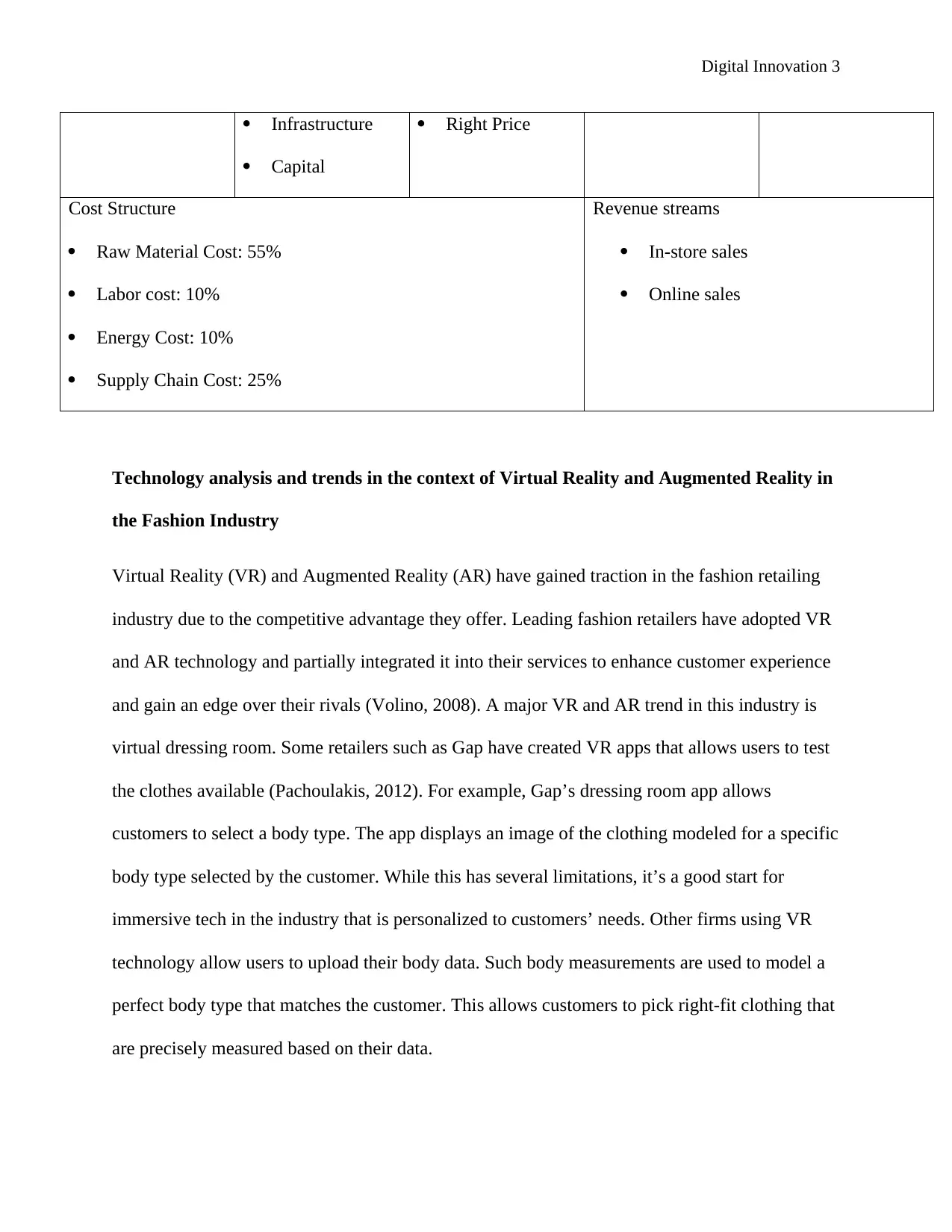
Digital Innovation 3
Infrastructure
Capital
Right Price
Cost Structure
Raw Material Cost: 55%
Labor cost: 10%
Energy Cost: 10%
Supply Chain Cost: 25%
Revenue streams
In-store sales
Online sales
Technology analysis and trends in the context of Virtual Reality and Augmented Reality in
the Fashion Industry
Virtual Reality (VR) and Augmented Reality (AR) have gained traction in the fashion retailing
industry due to the competitive advantage they offer. Leading fashion retailers have adopted VR
and AR technology and partially integrated it into their services to enhance customer experience
and gain an edge over their rivals (Volino, 2008). A major VR and AR trend in this industry is
virtual dressing room. Some retailers such as Gap have created VR apps that allows users to test
the clothes available (Pachoulakis, 2012). For example, Gap’s dressing room app allows
customers to select a body type. The app displays an image of the clothing modeled for a specific
body type selected by the customer. While this has several limitations, it’s a good start for
immersive tech in the industry that is personalized to customers’ needs. Other firms using VR
technology allow users to upload their body data. Such body measurements are used to model a
perfect body type that matches the customer. This allows customers to pick right-fit clothing that
are precisely measured based on their data.
Infrastructure
Capital
Right Price
Cost Structure
Raw Material Cost: 55%
Labor cost: 10%
Energy Cost: 10%
Supply Chain Cost: 25%
Revenue streams
In-store sales
Online sales
Technology analysis and trends in the context of Virtual Reality and Augmented Reality in
the Fashion Industry
Virtual Reality (VR) and Augmented Reality (AR) have gained traction in the fashion retailing
industry due to the competitive advantage they offer. Leading fashion retailers have adopted VR
and AR technology and partially integrated it into their services to enhance customer experience
and gain an edge over their rivals (Volino, 2008). A major VR and AR trend in this industry is
virtual dressing room. Some retailers such as Gap have created VR apps that allows users to test
the clothes available (Pachoulakis, 2012). For example, Gap’s dressing room app allows
customers to select a body type. The app displays an image of the clothing modeled for a specific
body type selected by the customer. While this has several limitations, it’s a good start for
immersive tech in the industry that is personalized to customers’ needs. Other firms using VR
technology allow users to upload their body data. Such body measurements are used to model a
perfect body type that matches the customer. This allows customers to pick right-fit clothing that
are precisely measured based on their data.
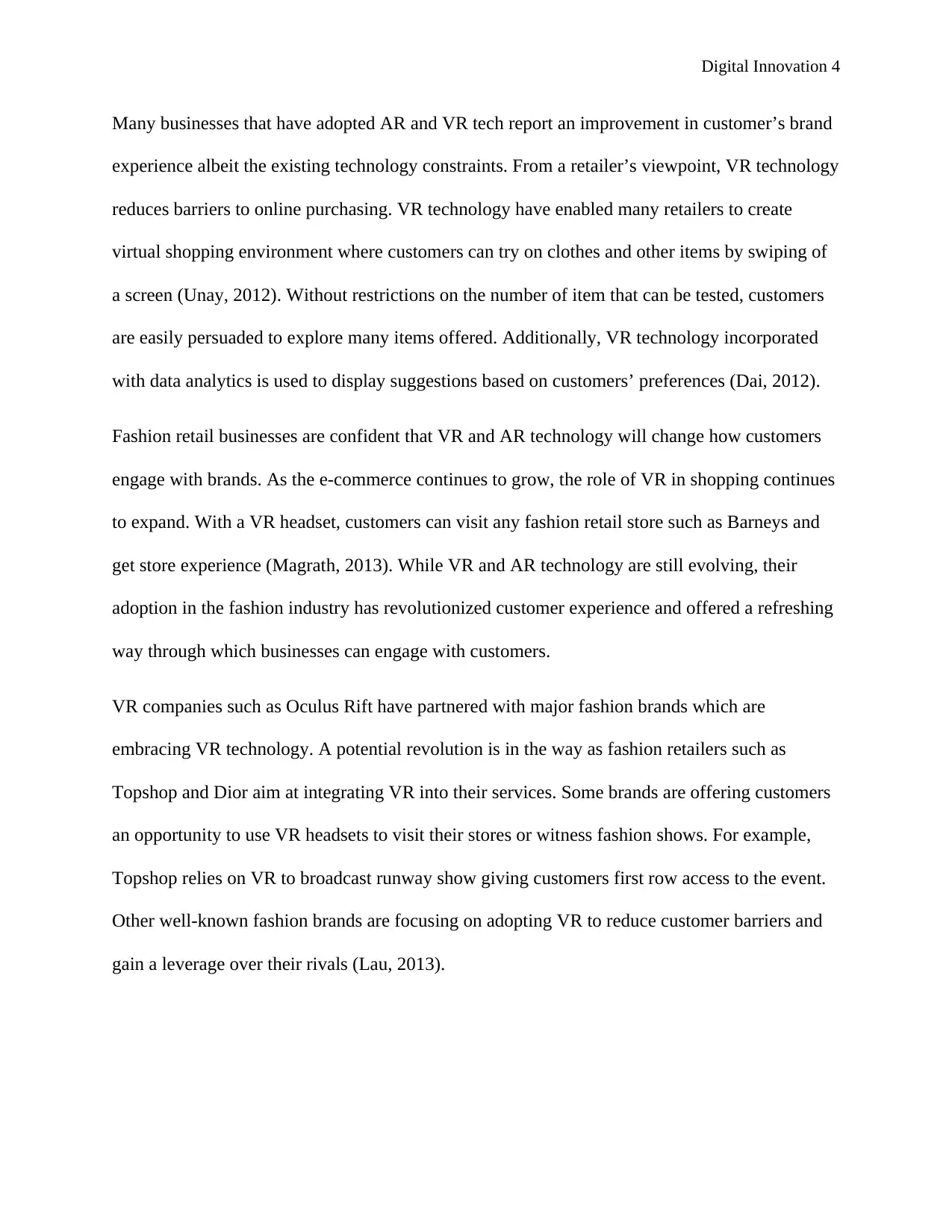
Digital Innovation 4
Many businesses that have adopted AR and VR tech report an improvement in customer’s brand
experience albeit the existing technology constraints. From a retailer’s viewpoint, VR technology
reduces barriers to online purchasing. VR technology have enabled many retailers to create
virtual shopping environment where customers can try on clothes and other items by swiping of
a screen (Unay, 2012). Without restrictions on the number of item that can be tested, customers
are easily persuaded to explore many items offered. Additionally, VR technology incorporated
with data analytics is used to display suggestions based on customers’ preferences (Dai, 2012).
Fashion retail businesses are confident that VR and AR technology will change how customers
engage with brands. As the e-commerce continues to grow, the role of VR in shopping continues
to expand. With a VR headset, customers can visit any fashion retail store such as Barneys and
get store experience (Magrath, 2013). While VR and AR technology are still evolving, their
adoption in the fashion industry has revolutionized customer experience and offered a refreshing
way through which businesses can engage with customers.
VR companies such as Oculus Rift have partnered with major fashion brands which are
embracing VR technology. A potential revolution is in the way as fashion retailers such as
Topshop and Dior aim at integrating VR into their services. Some brands are offering customers
an opportunity to use VR headsets to visit their stores or witness fashion shows. For example,
Topshop relies on VR to broadcast runway show giving customers first row access to the event.
Other well-known fashion brands are focusing on adopting VR to reduce customer barriers and
gain a leverage over their rivals (Lau, 2013).
Many businesses that have adopted AR and VR tech report an improvement in customer’s brand
experience albeit the existing technology constraints. From a retailer’s viewpoint, VR technology
reduces barriers to online purchasing. VR technology have enabled many retailers to create
virtual shopping environment where customers can try on clothes and other items by swiping of
a screen (Unay, 2012). Without restrictions on the number of item that can be tested, customers
are easily persuaded to explore many items offered. Additionally, VR technology incorporated
with data analytics is used to display suggestions based on customers’ preferences (Dai, 2012).
Fashion retail businesses are confident that VR and AR technology will change how customers
engage with brands. As the e-commerce continues to grow, the role of VR in shopping continues
to expand. With a VR headset, customers can visit any fashion retail store such as Barneys and
get store experience (Magrath, 2013). While VR and AR technology are still evolving, their
adoption in the fashion industry has revolutionized customer experience and offered a refreshing
way through which businesses can engage with customers.
VR companies such as Oculus Rift have partnered with major fashion brands which are
embracing VR technology. A potential revolution is in the way as fashion retailers such as
Topshop and Dior aim at integrating VR into their services. Some brands are offering customers
an opportunity to use VR headsets to visit their stores or witness fashion shows. For example,
Topshop relies on VR to broadcast runway show giving customers first row access to the event.
Other well-known fashion brands are focusing on adopting VR to reduce customer barriers and
gain a leverage over their rivals (Lau, 2013).
Secure Best Marks with AI Grader
Need help grading? Try our AI Grader for instant feedback on your assignments.
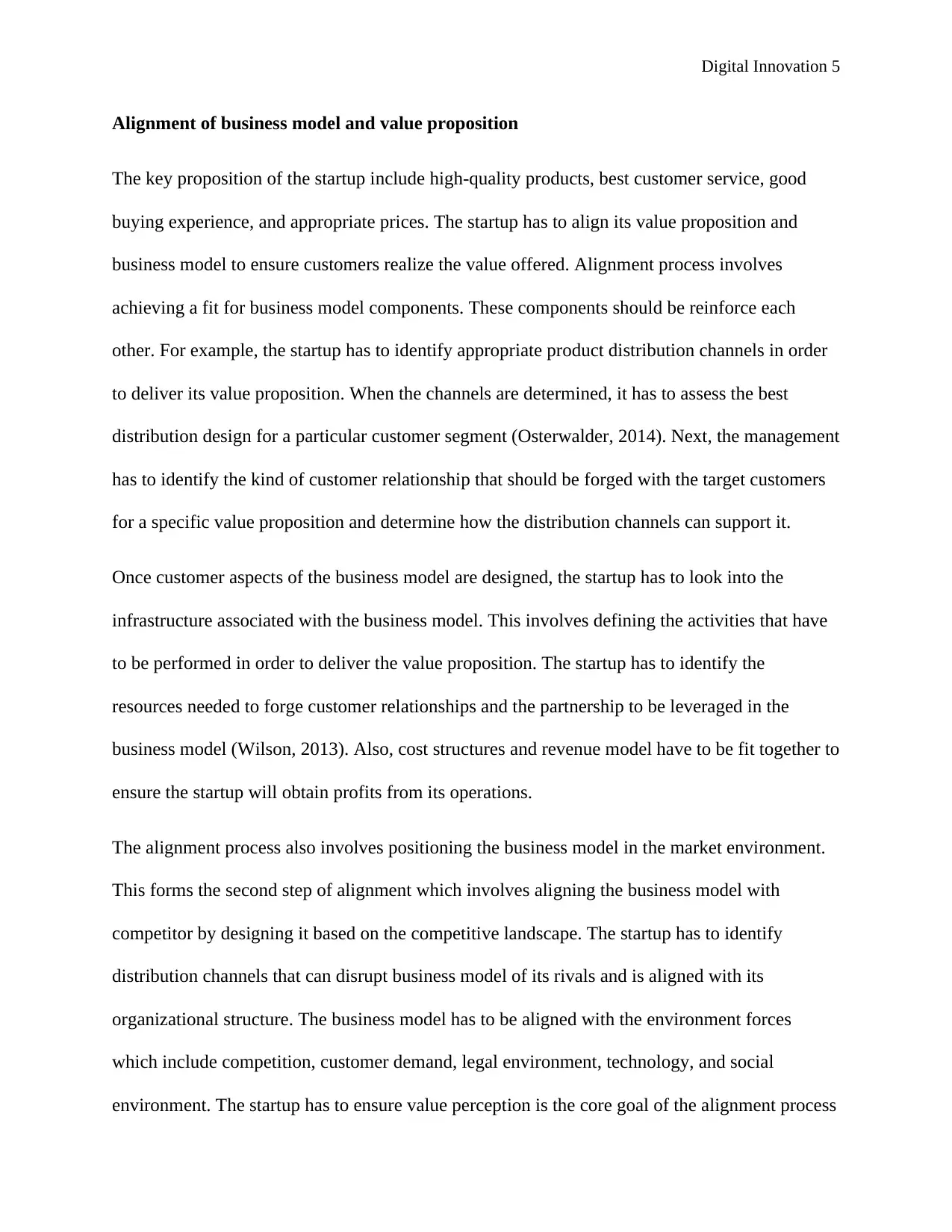
Digital Innovation 5
Alignment of business model and value proposition
The key proposition of the startup include high-quality products, best customer service, good
buying experience, and appropriate prices. The startup has to align its value proposition and
business model to ensure customers realize the value offered. Alignment process involves
achieving a fit for business model components. These components should be reinforce each
other. For example, the startup has to identify appropriate product distribution channels in order
to deliver its value proposition. When the channels are determined, it has to assess the best
distribution design for a particular customer segment (Osterwalder, 2014). Next, the management
has to identify the kind of customer relationship that should be forged with the target customers
for a specific value proposition and determine how the distribution channels can support it.
Once customer aspects of the business model are designed, the startup has to look into the
infrastructure associated with the business model. This involves defining the activities that have
to be performed in order to deliver the value proposition. The startup has to identify the
resources needed to forge customer relationships and the partnership to be leveraged in the
business model (Wilson, 2013). Also, cost structures and revenue model have to be fit together to
ensure the startup will obtain profits from its operations.
The alignment process also involves positioning the business model in the market environment.
This forms the second step of alignment which involves aligning the business model with
competitor by designing it based on the competitive landscape. The startup has to identify
distribution channels that can disrupt business model of its rivals and is aligned with its
organizational structure. The business model has to be aligned with the environment forces
which include competition, customer demand, legal environment, technology, and social
environment. The startup has to ensure value perception is the core goal of the alignment process
Alignment of business model and value proposition
The key proposition of the startup include high-quality products, best customer service, good
buying experience, and appropriate prices. The startup has to align its value proposition and
business model to ensure customers realize the value offered. Alignment process involves
achieving a fit for business model components. These components should be reinforce each
other. For example, the startup has to identify appropriate product distribution channels in order
to deliver its value proposition. When the channels are determined, it has to assess the best
distribution design for a particular customer segment (Osterwalder, 2014). Next, the management
has to identify the kind of customer relationship that should be forged with the target customers
for a specific value proposition and determine how the distribution channels can support it.
Once customer aspects of the business model are designed, the startup has to look into the
infrastructure associated with the business model. This involves defining the activities that have
to be performed in order to deliver the value proposition. The startup has to identify the
resources needed to forge customer relationships and the partnership to be leveraged in the
business model (Wilson, 2013). Also, cost structures and revenue model have to be fit together to
ensure the startup will obtain profits from its operations.
The alignment process also involves positioning the business model in the market environment.
This forms the second step of alignment which involves aligning the business model with
competitor by designing it based on the competitive landscape. The startup has to identify
distribution channels that can disrupt business model of its rivals and is aligned with its
organizational structure. The business model has to be aligned with the environment forces
which include competition, customer demand, legal environment, technology, and social
environment. The startup has to ensure value perception is the core goal of the alignment process
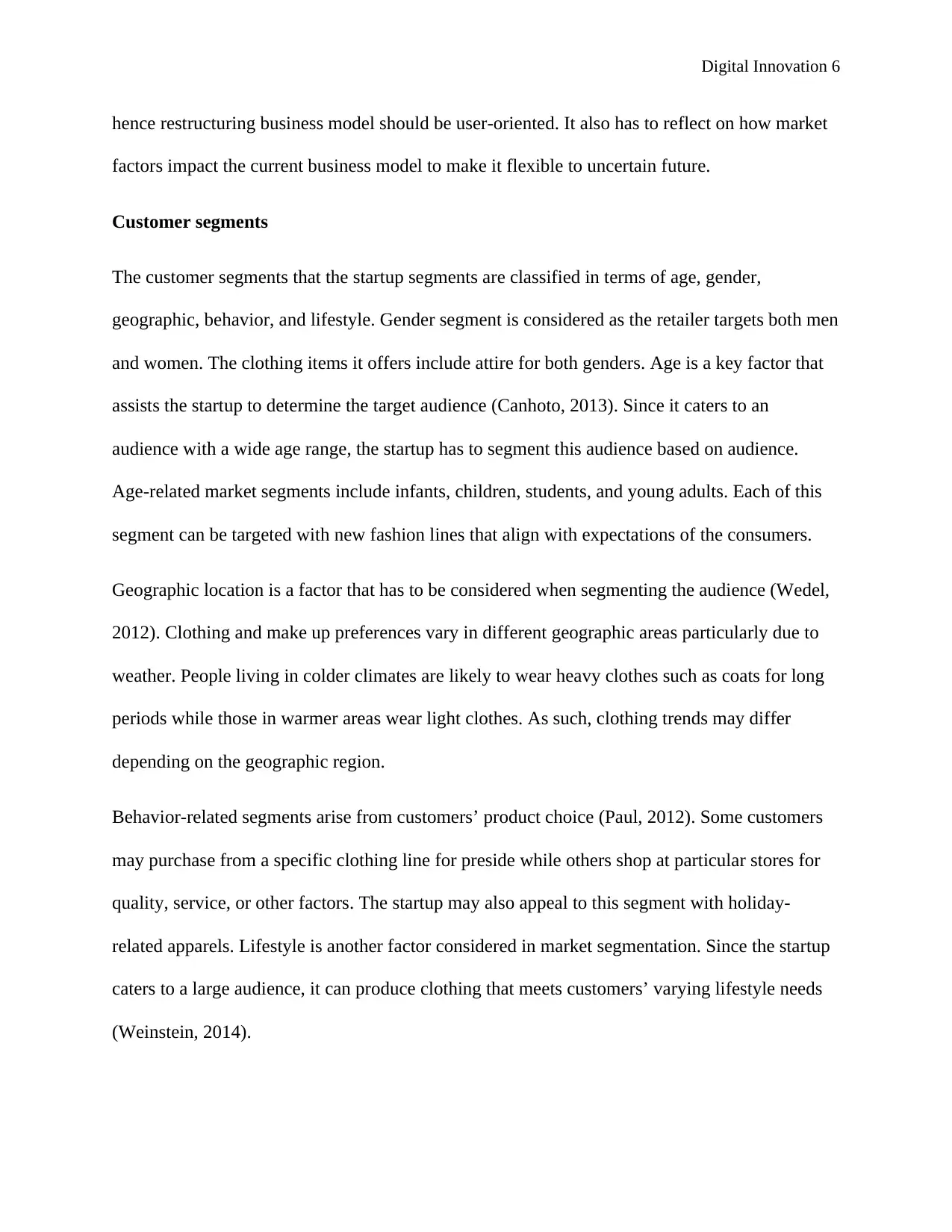
Digital Innovation 6
hence restructuring business model should be user-oriented. It also has to reflect on how market
factors impact the current business model to make it flexible to uncertain future.
Customer segments
The customer segments that the startup segments are classified in terms of age, gender,
geographic, behavior, and lifestyle. Gender segment is considered as the retailer targets both men
and women. The clothing items it offers include attire for both genders. Age is a key factor that
assists the startup to determine the target audience (Canhoto, 2013). Since it caters to an
audience with a wide age range, the startup has to segment this audience based on audience.
Age-related market segments include infants, children, students, and young adults. Each of this
segment can be targeted with new fashion lines that align with expectations of the consumers.
Geographic location is a factor that has to be considered when segmenting the audience (Wedel,
2012). Clothing and make up preferences vary in different geographic areas particularly due to
weather. People living in colder climates are likely to wear heavy clothes such as coats for long
periods while those in warmer areas wear light clothes. As such, clothing trends may differ
depending on the geographic region.
Behavior-related segments arise from customers’ product choice (Paul, 2012). Some customers
may purchase from a specific clothing line for preside while others shop at particular stores for
quality, service, or other factors. The startup may also appeal to this segment with holiday-
related apparels. Lifestyle is another factor considered in market segmentation. Since the startup
caters to a large audience, it can produce clothing that meets customers’ varying lifestyle needs
(Weinstein, 2014).
hence restructuring business model should be user-oriented. It also has to reflect on how market
factors impact the current business model to make it flexible to uncertain future.
Customer segments
The customer segments that the startup segments are classified in terms of age, gender,
geographic, behavior, and lifestyle. Gender segment is considered as the retailer targets both men
and women. The clothing items it offers include attire for both genders. Age is a key factor that
assists the startup to determine the target audience (Canhoto, 2013). Since it caters to an
audience with a wide age range, the startup has to segment this audience based on audience.
Age-related market segments include infants, children, students, and young adults. Each of this
segment can be targeted with new fashion lines that align with expectations of the consumers.
Geographic location is a factor that has to be considered when segmenting the audience (Wedel,
2012). Clothing and make up preferences vary in different geographic areas particularly due to
weather. People living in colder climates are likely to wear heavy clothes such as coats for long
periods while those in warmer areas wear light clothes. As such, clothing trends may differ
depending on the geographic region.
Behavior-related segments arise from customers’ product choice (Paul, 2012). Some customers
may purchase from a specific clothing line for preside while others shop at particular stores for
quality, service, or other factors. The startup may also appeal to this segment with holiday-
related apparels. Lifestyle is another factor considered in market segmentation. Since the startup
caters to a large audience, it can produce clothing that meets customers’ varying lifestyle needs
(Weinstein, 2014).
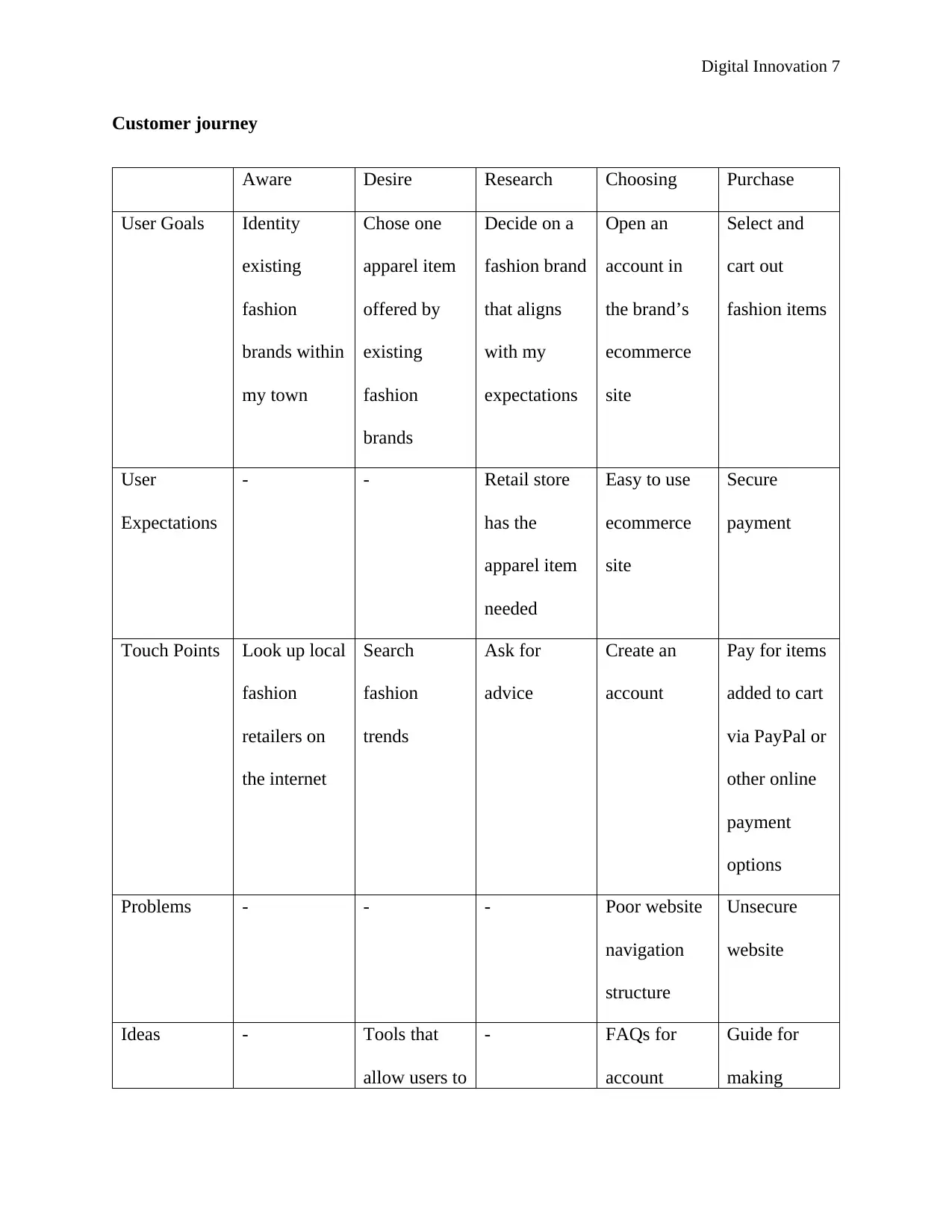
Digital Innovation 7
Customer journey
Aware Desire Research Choosing Purchase
User Goals Identity
existing
fashion
brands within
my town
Chose one
apparel item
offered by
existing
fashion
brands
Decide on a
fashion brand
that aligns
with my
expectations
Open an
account in
the brand’s
ecommerce
site
Select and
cart out
fashion items
User
Expectations
- - Retail store
has the
apparel item
needed
Easy to use
ecommerce
site
Secure
payment
Touch Points Look up local
fashion
retailers on
the internet
Search
fashion
trends
Ask for
advice
Create an
account
Pay for items
added to cart
via PayPal or
other online
payment
options
Problems - - - Poor website
navigation
structure
Unsecure
website
Ideas - Tools that
allow users to
- FAQs for
account
Guide for
making
Customer journey
Aware Desire Research Choosing Purchase
User Goals Identity
existing
fashion
brands within
my town
Chose one
apparel item
offered by
existing
fashion
brands
Decide on a
fashion brand
that aligns
with my
expectations
Open an
account in
the brand’s
ecommerce
site
Select and
cart out
fashion items
User
Expectations
- - Retail store
has the
apparel item
needed
Easy to use
ecommerce
site
Secure
payment
Touch Points Look up local
fashion
retailers on
the internet
Search
fashion
trends
Ask for
advice
Create an
account
Pay for items
added to cart
via PayPal or
other online
payment
options
Problems - - - Poor website
navigation
structure
Unsecure
website
Ideas - Tools that
allow users to
- FAQs for
account
Guide for
making
Paraphrase This Document
Need a fresh take? Get an instant paraphrase of this document with our AI Paraphraser

Digital Innovation 8
search for an
item in
different
categories,
price ranges,
etc.
opening
process
payment
online
Recommendation & Conclusion
Based on the assessment of the market and business model conducted, the startup has to
restructure itself in order to effectively handle customers’ needs and succeed in the target market.
First and foremost, the startup should develop a business model that incorporates emerging
technology. In particular, VR and AR technology should be considered to give the company a
competitive edge in the market. The startup also has to align its business model with its value
proposition. This involves restructuring the business model to become customer-oriented. As a
result, customers can realize the value offered by the company. Additionally, the company
should segment its target audience based on a set of factors in order to meet the needs of specific
group of customers.
As discussed, the key value proposition offered by the company include quality products and
best customer experience. The company’s business models is aligned with the value proposition
by defining actions to be taken to realize customer’s goals. The startup also considers
distribution channels and competitive landscape to ensure the business model can adapt to
market trends. Besides crafting a user-oriented model, the company has to consider VR and AR
search for an
item in
different
categories,
price ranges,
etc.
opening
process
payment
online
Recommendation & Conclusion
Based on the assessment of the market and business model conducted, the startup has to
restructure itself in order to effectively handle customers’ needs and succeed in the target market.
First and foremost, the startup should develop a business model that incorporates emerging
technology. In particular, VR and AR technology should be considered to give the company a
competitive edge in the market. The startup also has to align its business model with its value
proposition. This involves restructuring the business model to become customer-oriented. As a
result, customers can realize the value offered by the company. Additionally, the company
should segment its target audience based on a set of factors in order to meet the needs of specific
group of customers.
As discussed, the key value proposition offered by the company include quality products and
best customer experience. The company’s business models is aligned with the value proposition
by defining actions to be taken to realize customer’s goals. The startup also considers
distribution channels and competitive landscape to ensure the business model can adapt to
market trends. Besides crafting a user-oriented model, the company has to consider VR and AR
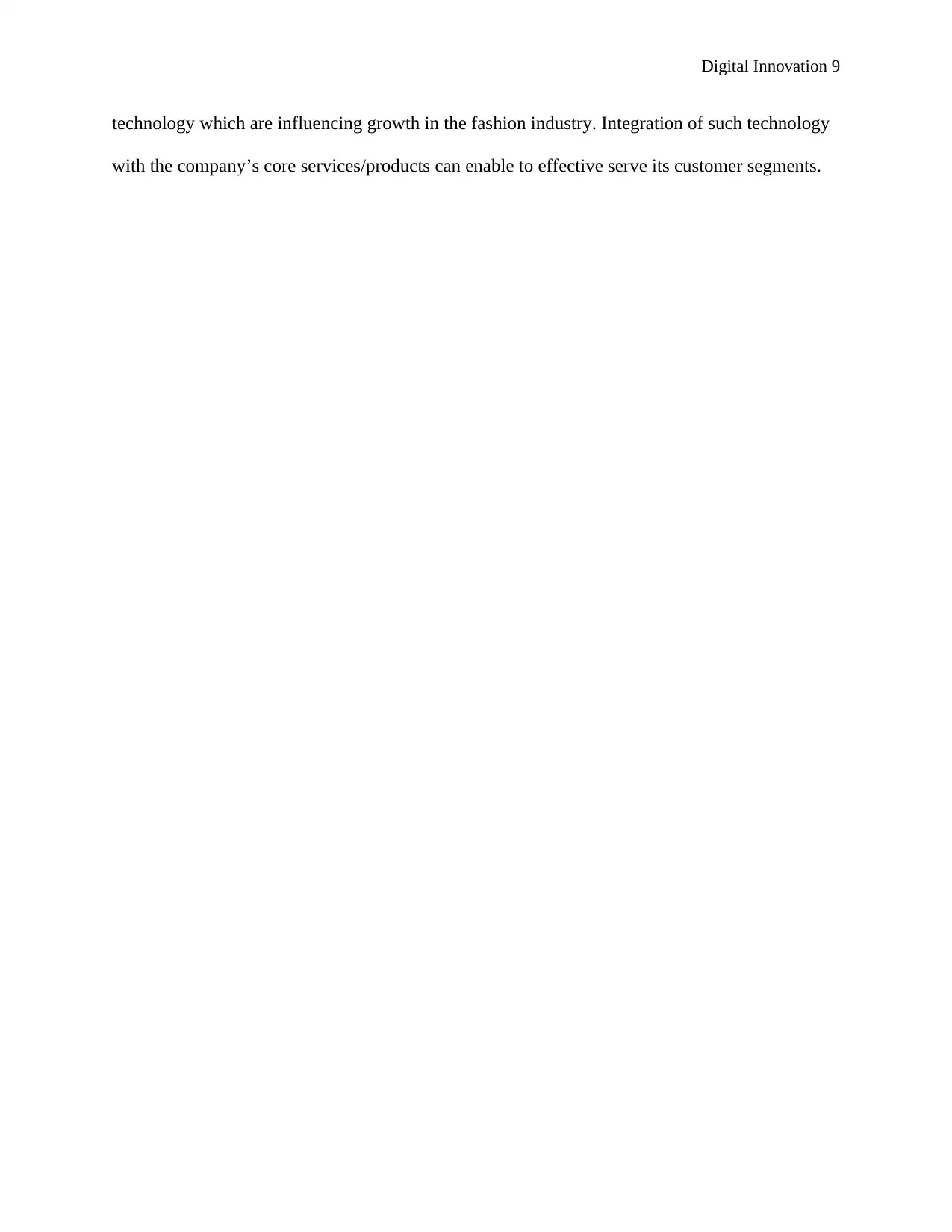
Digital Innovation 9
technology which are influencing growth in the fashion industry. Integration of such technology
with the company’s core services/products can enable to effective serve its customer segments.
technology which are influencing growth in the fashion industry. Integration of such technology
with the company’s core services/products can enable to effective serve its customer segments.
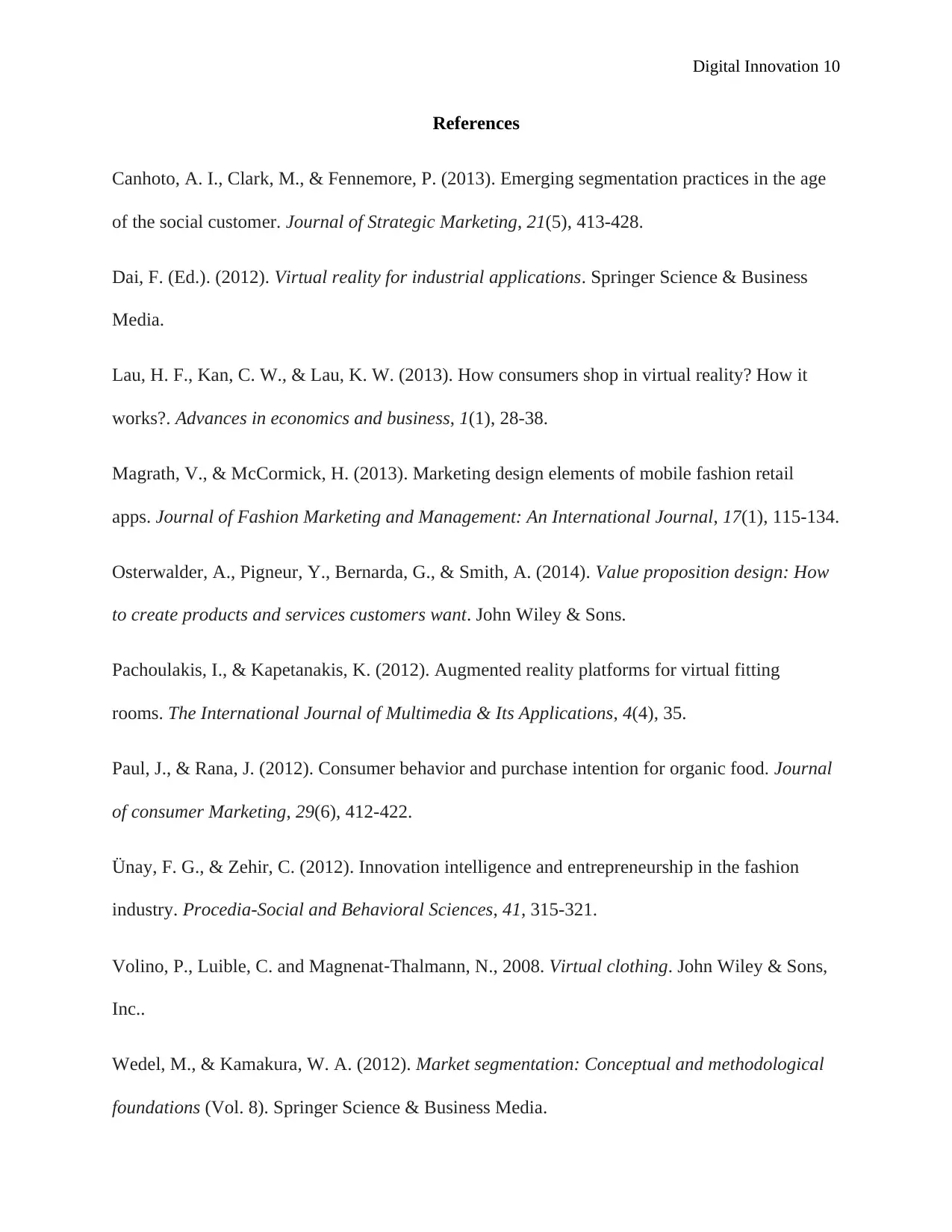
Digital Innovation 10
References
Canhoto, A. I., Clark, M., & Fennemore, P. (2013). Emerging segmentation practices in the age
of the social customer. Journal of Strategic Marketing, 21(5), 413-428.
Dai, F. (Ed.). (2012). Virtual reality for industrial applications. Springer Science & Business
Media.
Lau, H. F., Kan, C. W., & Lau, K. W. (2013). How consumers shop in virtual reality? How it
works?. Advances in economics and business, 1(1), 28-38.
Magrath, V., & McCormick, H. (2013). Marketing design elements of mobile fashion retail
apps. Journal of Fashion Marketing and Management: An International Journal, 17(1), 115-134.
Osterwalder, A., Pigneur, Y., Bernarda, G., & Smith, A. (2014). Value proposition design: How
to create products and services customers want. John Wiley & Sons.
Pachoulakis, I., & Kapetanakis, K. (2012). Augmented reality platforms for virtual fitting
rooms. The International Journal of Multimedia & Its Applications, 4(4), 35.
Paul, J., & Rana, J. (2012). Consumer behavior and purchase intention for organic food. Journal
of consumer Marketing, 29(6), 412-422.
Ünay, F. G., & Zehir, C. (2012). Innovation intelligence and entrepreneurship in the fashion
industry. Procedia-Social and Behavioral Sciences, 41, 315-321.
Volino, P., Luible, C. and Magnenat‐Thalmann, N., 2008. Virtual clothing. John Wiley & Sons,
Inc..
Wedel, M., & Kamakura, W. A. (2012). Market segmentation: Conceptual and methodological
foundations (Vol. 8). Springer Science & Business Media.
References
Canhoto, A. I., Clark, M., & Fennemore, P. (2013). Emerging segmentation practices in the age
of the social customer. Journal of Strategic Marketing, 21(5), 413-428.
Dai, F. (Ed.). (2012). Virtual reality for industrial applications. Springer Science & Business
Media.
Lau, H. F., Kan, C. W., & Lau, K. W. (2013). How consumers shop in virtual reality? How it
works?. Advances in economics and business, 1(1), 28-38.
Magrath, V., & McCormick, H. (2013). Marketing design elements of mobile fashion retail
apps. Journal of Fashion Marketing and Management: An International Journal, 17(1), 115-134.
Osterwalder, A., Pigneur, Y., Bernarda, G., & Smith, A. (2014). Value proposition design: How
to create products and services customers want. John Wiley & Sons.
Pachoulakis, I., & Kapetanakis, K. (2012). Augmented reality platforms for virtual fitting
rooms. The International Journal of Multimedia & Its Applications, 4(4), 35.
Paul, J., & Rana, J. (2012). Consumer behavior and purchase intention for organic food. Journal
of consumer Marketing, 29(6), 412-422.
Ünay, F. G., & Zehir, C. (2012). Innovation intelligence and entrepreneurship in the fashion
industry. Procedia-Social and Behavioral Sciences, 41, 315-321.
Volino, P., Luible, C. and Magnenat‐Thalmann, N., 2008. Virtual clothing. John Wiley & Sons,
Inc..
Wedel, M., & Kamakura, W. A. (2012). Market segmentation: Conceptual and methodological
foundations (Vol. 8). Springer Science & Business Media.
1 out of 10
Related Documents
Your All-in-One AI-Powered Toolkit for Academic Success.
+13062052269
info@desklib.com
Available 24*7 on WhatsApp / Email
![[object Object]](/_next/static/media/star-bottom.7253800d.svg)
Unlock your academic potential
© 2024 | Zucol Services PVT LTD | All rights reserved.





